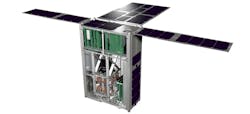Cold atom sensor technology being developed for space applications
FARNBOROUGH, England – On 18 July at the Farnborough International Show, Teledyne e2v announced plans for demonstrating cold atom sensor technology in space, while also showcasing some of its other space imaging capabilities
As part of a project funded by Innovate UK called Cold Atom Space Payload (CASPA), Teledyne e2v is developing a nanosatellite which aims to demonstrate cold atom sensor technology in space, while also developing a space flight ready variant of a cold atom chamber subsystem that will begin space qualification as part of the satellite, later this year.
New developments in quantum technology, suggests Teledyne e2v, have resulted in the ability to cool atoms close to absolutely zero by using lasers. Laboratory experiments have shown that these cold atoms can be used as ultra-sensitive sensors for measuring gravity.
“Gravity sensors can be made that are orders of magnitude more sensitive than current sensors,” said Paul Jerram, Chief Engineer, Space Imaging, Teledyne e2v. “In addition to the space-based application, this technology can be used in ground-based applications such as mining or searching for holes in the ground.”
The cold atom demonstration is being performed to show that the technology can work in space. Currently, however, there is a technology readiness barrier preventing it from being adopted in space, and this has been identified by the European Space Agency (ESA) who have this technology on their development roadmap, according to Teledyne e2v. Through the CASPA program, Teledyne e2v is addressing the technology readiness-level barrier via the first demonstration of cold atoms on a free-flying satellite.
The extreme sensitivity brought by cold atom sensors could provide the ability to finely monitor the movement of mass within Earth systems, bringing benefits to multiple applications, including polar ice mass monitoring, ocean currents, and sea level monitoring, according to Teledyne e2v.
In the coming months, further updates relating to the CASPA development program will be announced.
In addition to this announcement and the news that Teledyne e2v is developing CMOS TDI sensors for the UK Space Agency, the company showcased the CCD image sensors that are currently deployed on the ESA Gaia satellite, a five-year mission satellite launched at the end of 2014 that is being used to map the galaxy.
The CCD91-72 image sensor used for Gaia is a 4500 x 1966 image sensor with 30 x 10 µm pixels designed for TDI-mode operation. This mission, according to Jerram, was based around the capability of these CCDs. The CCD array was built by Astrium and contains 106 of these CCDs, offering a total of nearly 1 billion pixels. Gaia’s ultimately goal is to map the positions, parallaxes, and proper motions (movements across the sky) of around 1 billion objects in the Milky Way.
View more information on Teledyne e2v.
View more information on the Gaia mission.
